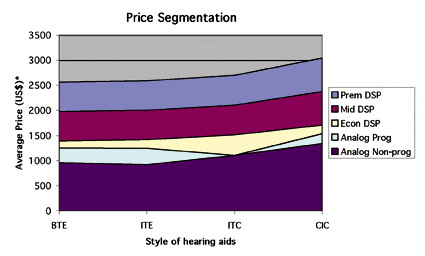|
This article was submitted to HR by David Fabry, PhD, when he was vice president of professional relations and education at Phonak Hearing Systems, Warrenville, Ill. Dr Fabry is currently affiliated with the University of Miami Medical Center, Miami, Fla. Correspondence can be addressed to [email protected] or . |
The increase in popularity of “mini” and “micro” behind-the-ear (BTE) devices has been due, in part, to the effective combination of style and substance that appeals to a new generation of hearing aid users. A recent survey by Kochkin1 for the Better Hearing Institute indicates that slim-tube open-fit devices have increased first-time hearing aid users by 29%, lowering the average age of new users by nearly a decade in the process.
In 2007, these devices have fueled large gains in BTE hearing aids overall, which now comprise roughly half of the total number of instruments dispensed in the United States, according to the Hearing Industries Association (HIA) statistics.2 Of this number, approximately 20% are “mini” or “micro” BTE devices.1
This dramatic growth has come largely at the expense of larger in-the-ear (ITE) devices, while completely-in-the-canal (CIC) devices have remained relatively stable at 10% of the total market.2 This suggests that many consumers still prefer the cosmetic advantages and ease-of-use of this style of hearing aid.
Furthermore, although directional microphones are not practical for use with CICs, preservation of pinna and concha resonances provides directional benefits comparable to those with the unaided ear.3 That said, CICs in the past have enjoyed limited success with high-frequency losses due to feedback, occlusion, and gain limitations.
Recent technical innovations, however, have addressed some of these shortcomings, providing hearing aid users with a choice of CIC or BTE solutions for “open” hearing aid fittings. This paper provides details regarding the technical and performance evaluation of a new CIC open-fit system designed for this purpose. Results indicate that subjects report more comfort, reduced occlusion, improved sound quality, and reduced feedback when compared with other commercially available devices for use with high-frequency hearing losses.
The Success of Open-Fit Strategies
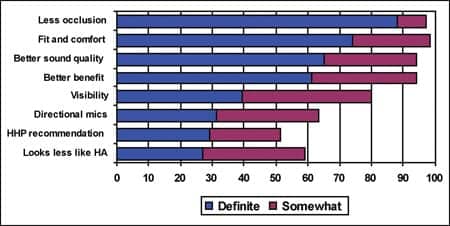
|
| FIGURE 1. Top eight reasons for fitting “slim tube” BTE hearing aids reported by clinicians.1 Blue region shows percentage of patients reporting “definite” improvement; red bars indicate percentage reporting “somewhat” improved. |
“Open” hearing aid fitting strategies have existed for decades, using large vents to minimize occlusion in patients with typical low-frequency hearing sensitivity (thresholds less than 25-30 dB HL) and high-frequency hearing losses up to 50 dB HL. The challenge, however, has been to provide high-frequency audibility without feedback—a situation that often compromised the success of early systems.
The development of real-time feedback phase inversion systems for use with digital hearing aids has dramatically improved this situation, particularly for the current generation of “mini” and “micro” BTE devices that permit larger vent sizes and provide greater separation of the hearing aid microphone and receiver (compared to ITEs). As mentioned earlier, this factor, in combination with aging “Baby Boomers” who are beginning to feel the impact of their “rock and roll” lifestyles with noise-induced and presbycusic hearing losses, has led to considerable increases in BTE sales in the US market. Consumers and clinicians alike listed minimal occlusion and reduced feedback as primary reasons for improved outcomes in comparison with other devices (Figure 1).
Continued improvements in feedback cancellation algorithms, in combination with further miniaturization of hearing aid components, now provide the potential for open-fit devices in small “custom” ITEs, which are favored by many patients for cosmetic, ease-of-use, and performance reasons. The following addresses the components related to success with open-fit devices, with special emphasis on whether CIC devices can provide comparable benefits to micro-BTE devices for this purpose.
SOAP: A Plan for Success with Open Fittings
In medical settings, “S-O-A-P” notes are written to improve communication among those caring for a patient by recording the symptoms, assessment, and plans in an organized format. The letters S-O-A-P represent Subjective, Objective, Assessment, and Plan. Writing SOAP notes facilitates better care of the patient, and the notes are used in the patient’s record for review and quality control of treatment outcomes.
With regard to open hearing aid fittings, SOAP also provides an acronym that may serve as a structured approach for improving communication regarding potential for patient benefits, based on:
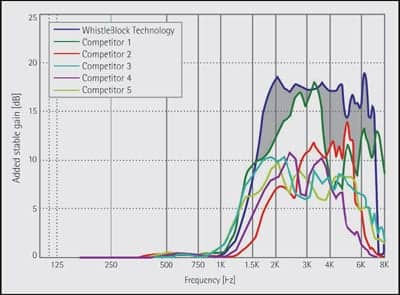
|
| FIGURE 2. Added stable gain (ASG) measures as a function of frequency for six different commercially available open-fit hearing aid systems. Gray region indicates areas on improved ASG for WhistleBlock over benchmark devices. |
Smooth frequency response. This is accomplished using appropriate “acoustic matching” between the in situ hearing aid response and the residual ear canal volume, reflecting the impact of tubing resonances, vent volume, length, and diameter, and the impedance of the ear and hearing aid receiver. Hearing aids that minimize resonant peaks will provide higher sound quality and speech intelligibility than systems that do not take these factors into account.4,5 In open-fit devices, lack of proper acoustic frequency response optimization can also lead to increased feedback.
Occlusion management. This is done using acoustically optimized venting (see below). In the past, this has typically meant using as large a vent as possible—but without consideration for the individual patient’s hearing loss or acoustical vent mass effects (ie, vent diameter, length, and volume). When these factors are considered, however, vent dimensions may be more precisely calculated to minimize occlusion without feedback at target gain values.
Kiessling et al6 reported that acoustic mass is directly related to reported occlusion by hearing aid wearers. Vent mass is an essential factor relating to occlusion, but it is not possible to optimize vent size without small components, optimal placement, and reliable shell manufacturing techniques. In modern hearing aids, this is made possible, in part, by digital circuitry and digital shell production.
Audibility. Early open-fit systems reduced the potential for feedback by reducing high-frequency gain, which in turn impacted speech intelligibility for high-frequency fricative and sibilant consonant sounds. Effective open-fit systems must not sacrifice audibility—particularly in the high frequencies—in order to prevent feedback when large vents are used.
Prevention of feedback. Modern feedback phase inversion systems provide added stable gain (ASG) beyond what is available when the algorithm is not active. As stated above, however, the interplay between audibility and ASG should be evaluated in situ to ensure speech audibility for different vocal efforts and in dynamic situations.
A series of laboratory and real-world conditions that compare the effectiveness of micro-BTE and CIC styles for open fittings was devised, using the above metrics as measurement variables. The objectives of the study were to answer the following questions:
- Can occlusion and feedback be reduced in CIC instruments to comparable levels for micro-BTE devices for typical open-fit candidates?
- Will state-of-the-art feedback management provide effective performance in combination with speech audibility for varying speech input levels and dynamic situations?
- Will acoustic optimization of venting and hearing aid parameters provide smoother in situ responses that relate positively to user benefits, in terms of sound quality, occlusion, comfort, and speech intelligibility? That is, rather than simply designing the vents to be as large as possible, given the size of the components, does it make sense to design and optimize the locations of vent pathways and internal hearing aid components to best match the acoustic properties of the device to the patient’s ear and specific hearing loss?
Laboratory Assessment of a New Feedback Cancellation Algorithm
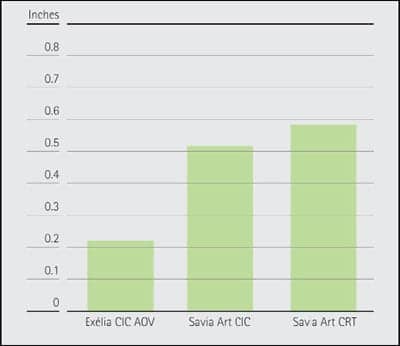
|
| FIGURE 3. Audiometric characteristics (average, standard deviation, and range) for right (red) and left (blue) ears of the 26 subjects who participated in the study. |
The primary difference between present and past open-fit devices relates to prevention of feedback under real-world conditions; as such, the technical performance of any system should be compared to benchmark data to determine the potential for success. Freed and Soli8 and Merks et al9 have developed an approach that uses “added stable gain” (ASG) as a measure of technical performance, using an artificial head placed in a sound-treated box with a linear motor to move an object reproducibly close to the ear and the hearing instrument. This allows for a realistic and reproducible simulation of different feedback conditions.
Using this type of test system, the performance of a new feedback cancellation system (WhistleBlock) used in a new open-fit CIC device (Exélia Petite CIC) was compared to existing commercial products in terms of ASG. ASG calculates how much more gain may be applied with the feedback canceller turned on versus feedback canceller turned off.
Figure 2 illustrates ASG measured as a function of frequency for six different hearing instrument devices, and indicates that although some systems provide comparable peak ASG, the new feedback management system provides significantly more added stable gain than benchmark systems across a broad range of frequencies between 1,500 Hz and 6,000 Hz.
Clinical Assessment of a New CIC Open-Fit Device
Subjects. A total of 26 hard-of-hearing patients (16 male, 10 female) served as subjects. Average age was 65 years, and the majority were previous hearing aid users who reported occlusion and/or feedback problems. All were typical candidates for open-fit candidates, and average audiometric thresholds are presented in Figure 3.
Hearing Aids. Each subject was fitted binaurally with three sets of hearing aids:
- Exélia CIC Petite with acoustically optimized venting (AOV)
- Savia Art 11 CIC
- microSavia Art CRT with open dome tip
The hearing aids were programmed, using each subject’s audiometric thresholds input into iPFG v2.0 software, to meet NAL-NL1 prescriptive targets. Subsequently, real-ear measurements were made, using the Audioscan Verifit, to evaluate speech audibility for soft (50 dB SPL) and moderate (65 dB SPL) recorded speech for a male talker (carrot passage), and loud sounds (85 dB SPL MPO sweep) did not produce loudness discomfort.
Speech Intelligibility Index (SII) measurements were computed for each instrument for the 50 and 65 dB SPL conditions, to evaluate the degree to which each system provided speech audibility for real-world stimuli. The SII is an updated metric derived from Articulation Theory that uses one-third octave band-weighted calculations of speech audibility, taking into consideration the speech and noise levels in a listening environment, degree of hearing loss, and the degree to which sounds have been amplified by hearing aids in the test condition. Unlike the original Articulation Index (AI) calculations, SII includes level distortion effects that may occur with amplified sound, so it is ideal for predicting benefit with hearing aids. SII values vary from 0 to 1.0, and use a transfer function to predict speech intelligibility for specific listening materials (eg, monosyllabic words, nonsense syllables, sentence materials). The SII has proven to be a very robust predictive measure for predicting performance for both normal-hearing and hearing-impaired persons in a variety of listening environments.
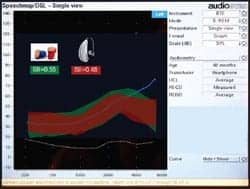
|
| FIGURE 4. Average amplified speech values and SII calculations for Exélia CIC Petite (green) and microSavia Art CRT (red). |
In addition to real-ear measurements, subjects evaluated the effectiveness of the feedback cancellation system for each device under three conditions:
- When the feedback test was not performed (or without any feedback canceller)
- When the feedback test was run with the instrument in the 2-cc coupler
- When the feedback test was run in situ using the iPFG fitting software
For each condition, both ears were tested for the presence of feedback under “dynamic” listening conditions by slowly moving the subject’s left or right hand in a parallel plane from the pinna, beginning at 12 inches and moving until feedback occurred. The hand-to-ear distance (in inches) when feedback occurred was recorded binaurally for all three hearing aids. In addition, for each condition, subjects rated two music passages for sound quality and for the presence of entrainment.
Finally, each subject wore the Exélia CIC Petite devices for a period of 2 weeks, after which they completed a subjective questionnaire (available as Appendix I) regarding the benefits in terms of sound quality, speech intelligibility, occlusion, and feedback compared with their previous hearing instruments.
Study Results
Audibility calculation. All three devices evaluated in this study feature multiple-channel compression and wideband output transducers. As a result, it is not surprising that calculated SII was similar for conversational speech levels (65 dB SPL), ranging from 0.77 to 0.79.
As with all wide dynamic range compression (WDRC) systems, however, feedback is most likely to occur for soft inputs, so the fact that average calculated SII was greater for Exélia CIC Petite (0.55) than for Savia Art CRT (0.48) suggests that the improved feedback canceller provided increased audibility for soft sounds (Figure 4). In fact, for 22 of 26 subjects, calculated SII was greater for the Exélia CIC Petite than for the Savia Art CRT for the 50 dB SPL aided speech condition.
Of course, one could also conclude that this result was due to increased low-frequency gain—and presumably occlusion—because of higher acoustic mass with the CIC device than with the micro BTE. Results of subjective occlusion ratings, however, indicate otherwise; rated occlusion values for Exélia CIC Petite were comparable to or better than Savia Art CRT values for 20 out of 26 subjects. This combination of improved audibility for soft speech and comparable subjective occlusion values suggests that acoustically optimized venting, in combination with effective feedback cancellation, provides a favorable outcome for the CIC device with open fittings.
Feedback. For all three hearing aids, optimization of the feedback cancellation system via in situ feedback measurement resulted in no feedback for static listening conditions. In comparison, when the feedback cancellation system was not run, or when it was run in the coupler (ie, rather than in the ear), static feedback occurred for 12 and 4 subjects, respectively, out of the 26 total subjects.
The results of the “dynamic” feedback test revealed a statistically significant improvement for Exélia CIC Petite with AOV versus the Savia Art 11 CIC and microSavia Art CRT devices, as shown in Figure 5. For left and right ears, respectively, feedback occurred with the subject’s hand moving toward the ear at a distance of 0.21 and 0.22 inches with Exélia, while both Savia Art models produced feedback at an average distance in excess of 0.5 inches. Furthermore, feedback occurred at greater average distances for both ears when the feedback test was not measured (2.8 for both ears) or when it was measured in the coupler (1.1 and 1.2 inches for left and right ears, respectively). For five subjects, the dynamic test could not be completed due to the presence of feedback in static situations when the feedback measurement was not run.
These results confirm the importance of in situ feedback optimization for use with “open” fits, consistent with the overall acoustical optimization process.
Smoothness of REAR. A modification Frequency Response Smoothness Quantification Index (FReSQI) developed by Schultz et al10 was used to assess the smoothness of the real-ear aided response (REAR). The FReSQI determines the irregularity of hearing aid frequency responses by computing the “error” between the REAR and a second order polynomial computed between the selected low- and high-frequency cutoff.
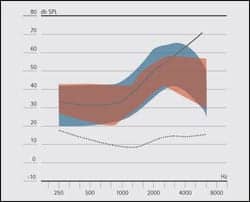
|
| FIGURE 5. Average distance at which feedback occurred for the “dynamic” feedback measurement, when subjects moved their hand in a parallel plane toward the ear, beginning from a distance of 12 inches until feedback occurred or they touched the ear. |
Using this measure, the computed FReSQI values were lower for Exélia CIC Petite (15.1) than for either the Savia Art 11 CIC (26.1) or microSavia Art CRT (25.2). Although additional research is needed, Davis and Davidson4 reported that subjects preferred hearing aids with smoother frequency responses, as expressed by lower FReSQI results, over those with greater frequency response peaks.
Subjective questionnaires. Subjects responded to an initial fit questionnaire after being fit with each of the three devices. Average subjective occlusion ratings for Exélia indicated superior sound quality (2.96/4) and loudness (3.42/4.0) of their own voice, in comparison to to Savia Art 11 CIC and microSavia Art CRT.
In addition, subjective questionnaire data were obtained from the subjects after a 2-week trial period with the Exélia CIC Petite devices for the questionnaire (Appendix I of the online version of this article). Results indicate that subjects wore the hearing aids an average of 9.5 hours daily, for a total of 155 hours total use. The subjects also indicated experiencing excellent subjective performance for loudness, speech intelligibility in quiet and in noise, the loudness and sound quality of their own voice, and overall satisfaction. Because these data were not available for the other two devices, however, it is impossible to make direct comparisons across devices.
Discussion
In response to the experimental questions, the findings of the present study indicate that acoustic optimization of venting and hearing aid parameters provide smoother in situ responses that relate positively to user benefits in terms of sound quality, occlusion, and speech intelligibility. In addition, measured and subjective feedback and occlusion with the Exélia CIC Petite were reduced relative to those observed with the microSavia Art CRT micro BTE device for typical “open fit” hearing aid candidates. Finally, Exélia’s improved feedback management system resulted in improved feedback cancellation for “dynamic” listening conditions while also providing improved audibility for soft input speech levels.
In summary, effective performance with “open fit” devices depends on:
- Smooth in situ frequency response
- Occlusion management
- Audibility for soft speech and other sounds
- Prevention of feedback for static and dynamic listening conditions
Achieving these objectives will provide a plan for success with these devices, and the new digital acoustic processing, digital shell manufacturing technology, acoustically optimized venting offered in the Exélia CIC Petite instrument provides patients with a viable alternative for open fits in addition to micro BTE devices.
Acknowledgement
The author thanks Becky Finlen, AuD, from Phonak for her assistance with the test protocol and data collection.
What Is an “Acoustically Optimized” Vent?
Acoustically optimized vents take advantage of the vent mass information as it applies to the total acoustic sound performance of the hearing instrument.
Acoustical mass describes the effect of the vent on the acoustical response of the hearing instrument. The amount of sound that escapes through the vent depends not only on the diameter alone, but also on vent length and shape. For example, the same acoustical mass can be achieved with very different dimensions; a small vent area with a short tube can be equivalent to a large vent area with a long tube.
The use of digital shell modeling has facilitated acoustical optimization of vent parameters to be much more accurate and repeatable than through previous methods. For example, for each patient, a multidimensional equation is used, comprising audiometric thresholds, target gain values, and potential for occlusion and feedback to determine a weighted target mass value. Subsequently, software is used to precisely model vent characteristics by independently manipulating vent shape (eg, circular, D-shape, IROS, Inverse IROS, discontinuous D-Shape), diameter (eg, constant or variable), and overall length to achieve the calculated target mass value while also guaranteeing the smallest possible instrument size by optimizing the placement of internal hearing aid components (eg, circuitry and receiver) inside the shell.
The resulting vent design and acoustic mass value are stored digitally and transferred to the hearing instrument during the final stages of the production process, when the shell is digitally “printed.”7 This value is available for use by the programming software to assist with optimal frequency shaping, feedback cancellation, and occlusion management.
References
- Kochkin S. Thin tube mini-BTE survey. Alexandria, Va: Better Hearing Institute; September 11, 2006.
- Hearing Industries Association. Fourth quarter 2007 industry statistical report. Alexandria, Va: HIA; February 2008.
- Roberts M, Schulein R. Measurement and intelligibility optimization of directional microphones for use in hearing aid devices. Paper presented at: 103rd AES Convention; September 1997; New York City. Paper 4515 (B3).
- Davis L, Davidson S. Preference for and performance with damped and undamped hearing aids by listeners with sensorineural hearing loss. J Sp Hear Res. 1996;39:483-493.
- Van Buuren RA, Festen JM, Houtgast T. Peaks in the frequency response of hearing aids: evaluation of the effects on speech intelligibility and sound quality. J Sp Hear Res. 1996;39:239-250.
- Kiessling J, Brenner B, Thunberg-Jespersen C, Groth J, Dyrlund O. Occlusion effect of earmolds with different venting systems. J Am Acad Audiol. 2005;16(4):237-249.
- Sullivan RF. Why morphology matters: practical dispensing applications of 21st century shell design technologies, Part 1. Hearing Review. 2008;15(2):12-19.
- Freed D, Soli S. An objective procedure for evaluation of adaptive antifeedback algorithms in hearing aids. Ear Hear. 2006; 27(4):382-398.
- Merks I, Banerjee S, Trine T. Assessing the effectiveness of feedback cancellers in hearing aids. Hearing Review. 2006;13(4):53-57.
- Schultz TY, Davidson SA, Davis LA, Krisnamurthy AK. Quantifying the irregularity of hearing aid responses. ASHA. 1992;34:199.




